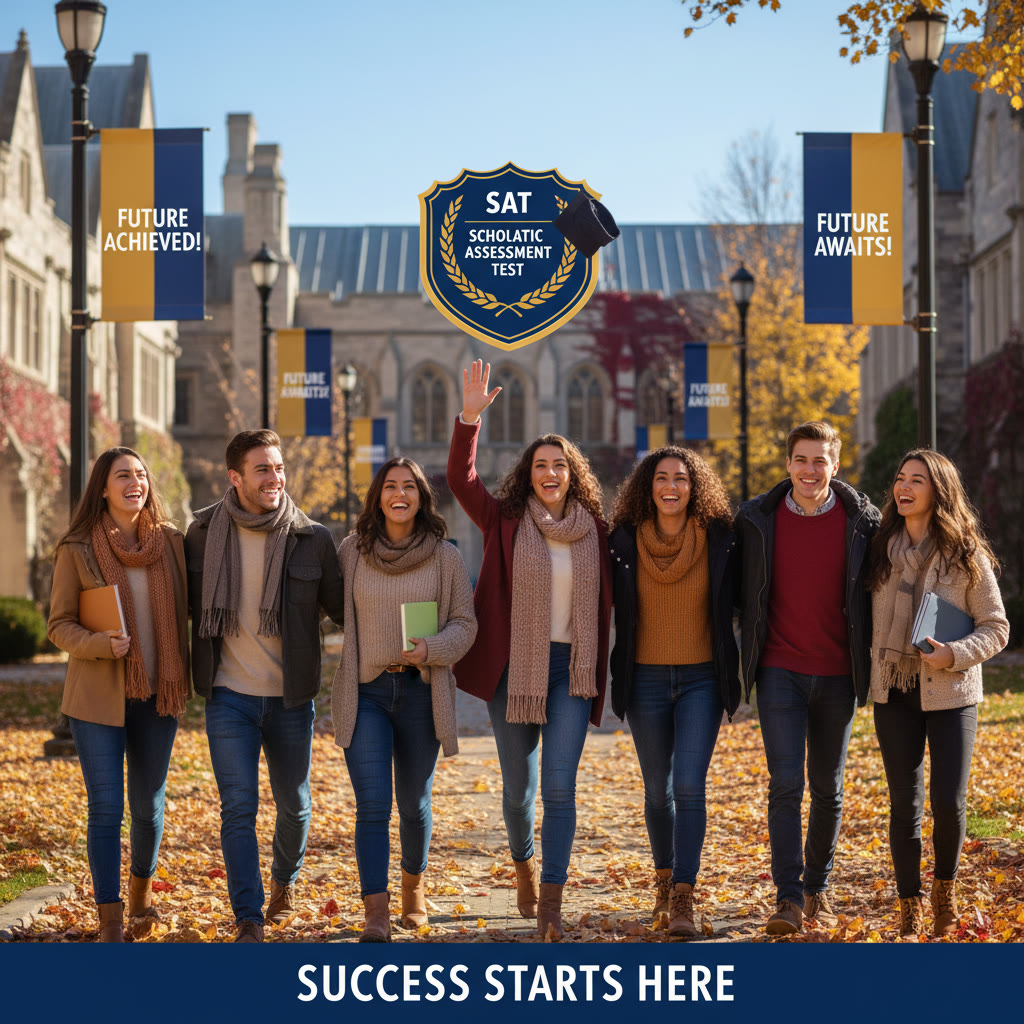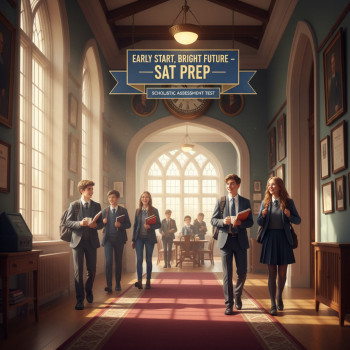You’re Not Alone: Why a sub-1300 SAT Is Still a Strong Starting Point
Take a breath. If your SAT score is under 1300, you are in good company — and you still have many routes to colleges that fit your goals, interests, and budget. Admissions officers read applications like stories, not numbers. A score is one chapter; grades, activities, essays, recommendations, demonstrated interest, and fit complete the book. This post is for students and parents who want to translate a realistic SAT result into a smart application strategy that opens doors rather than shuts them.

How Colleges View a Score Below 1300
A sub-1300 SAT can mean different things depending on the school. For highly selective colleges, it may fall below the middle 50% range; for many public universities and a broad list of private colleges it’s well within their admitted range. Also remember: many campuses remain test-optional or test-flexible — meaning your score is optional, considered if submitted, and often used for scholarship or placement decisions rather than as a strict gatekeeper.
Key factors admissions teams will weigh alongside your SAT
- High school GPA and the rigor of your coursework (AP, IB, dual enrollment).
- Trends — are your junior and senior year grades improving?
- Extracurriculars and leadership — depth often matters more than breadth.
- Compelling personal essays that show character, curiosity, and resilience.
- Letters of recommendation highlighting intellectual promise or character.
- Demonstrated interest and fit — why that college, why you now?
Types of Colleges That Often Welcome Applicants with SATs Below 1300
Below are broad categories of colleges that typically admit students with SAT scores under 1300. These are representative paths — not guarantees — but they’ll help you identify where your profile might align.
1. Regional public universities and state schools
Many state universities have broad enrollment missions and middle 50% SAT ranges that comfortably include scores below 1300. These schools offer strong degree programs, career services, internships tied to local industries, and in-state tuition benefits.
2. Test-optional private colleges
Small to mid-size private colleges often emphasize holistic review. When scores are optional, a strong application package — especially an engaging essay and solid transcript — can outweigh a middling SAT.
3. Colleges with strong transfer pathways
Some students choose a two-year community college or a less-selective four-year college to build GPA and then transfer to a more selective institution. This is a strategic, cost-effective route many successful applicants use.
4. Career-focused and technical colleges
If you’re aiming for hands-on fields (nursing, some engineering tech, design, culinary arts), many reputable programs prioritize portfolios, interviews, or professional prerequisites over standardized scores.
How to Build a College List When Your SAT Is Under 1300
Build a balanced list of reach, match, and safety schools — but define those categories by holistic fit, not just selectivity. Use these practical steps.
Step-by-step approach
- Start with priorities: location, major, campus size, cost, and career support.
- Identify two to four target programs where your interests align with departmental strengths.
- Look for test-optional policies if you want to avoid submitting your SAT score — but check scholarship rules (some scholarships still require scores).
- Include community college or guaranteed transfer programs if affordability or a two-step plan appeals to you.
- Apply broadly enough to protect against unpredictability — aim for at least 8–12 applications.
Examples of Colleges and Approaches That Work Well (by category)
The following examples describe typical institutions and strategies — not exhaustive lists. Use these as templates to search locally and nationally for schools matching your priorities. Many reputable choices exist across the U.S., including strong state universities, proven test-optional privates, and community college transfer routes.
Regional Public University — The Solid Option
Why it fits: strong majors, big alumni networks, internship connections, and reasonable tuition for in-state families.
- Application strategy: emphasize GPA, AP/dual enrollment, and local internships.
- Essay tip: explain how you’ll add to campus life (clubs, local volunteering, research interests).
Test-Optional Private College — The Holistic Play
Why it fits: smaller classes, personalized advising, and focus on mentoring.
- Application strategy: submit strong recommendations and a narrative-driven essay.
- Scholarships: many schools offer merit aid judged on GPA, leadership, and essays; test-optional doesn’t mean scholarship-optional.
Community College to Transfer — The Budget-Savvy Ambition
Why it fits: save money, boost GPA, and use transfer agreements to step into a selective program later.
- Application strategy: maximize community college GPA and build relationships with faculty for transfer recommendations.
- Timing: plan courses to match the intended major so credits transfer smoothly.
Table: Example Schools and How They Can Work For You
The table below shows illustrative categories and applicant strategies; customize these suggestions for the colleges you choose.
| College Type | Typical Mid 50% SAT Range (Illustrative) | Why It Works for Sub-1300 Scores | Application Focus |
|---|---|---|---|
| Regional Public University | 1000–1250 | Broad admissions mission; strong majors and campus resources. | GPA, activities, local ties, supplemental essays |
| Test-Optional Private College | Varies widely | Holistic review values essays, recommendations, and fit. | Compelling personal statement, strong recs |
| Community College (2-year) | Not applicable | Cost-effective start and clear transfer pathways to four-year colleges. | High grades, transfer advising, extracurricular leadership |
| Career/Technical College | Not applicable | Focus on skill-training and industry connections; portfolio or interview matters. | Portfolio, certifications, internships |
Practical Steps to Strengthen Your Profile (Beyond Retaking the SAT)
Retaking the SAT is a valid option, but it’s not the only way to improve your chances. Here are concrete actions you can take this month, this semester, and this year.
Immediate actions (this month)
- Inventory your application: transcript, activities, awards, test scores, essays, and recs.
- Make a deadline calendar for applications, scholarships, and financial aid (FAFSA opens in October each year).
- Ask for at least two recommendation letters early — provide teachers with a one-page resume and context.
Short-term (this semester)
- Improve your transcript trajectory: take stronger courses and aim for higher grades in junior/senior year.
- Start drafting your personal statement and supplements — authentic stories beat generic brag lists.
- Build relationships with counselors and teachers who can speak to your growth.
Longer-term (application year)
- Consider targeted SAT improvement if you can realistically add 40–100 points with focused prep.
- Collect meaningful evidence of impact (projects, internships, leadership roles) that align with your intended major.
- Plan campus visits or virtual meetings with admissions officers to show demonstrated interest where it matters.
Essays and Stories: Where Students with Lower SATs Shine
An honest, well-crafted essay can be transformative. Admissions committees want to know: who are you beyond numbers? What drives you? What obstacles did you overcome? How do you think and create?
Writing tips for memorable essays
- Start with a small, specific moment that reveals a larger truth about you.
- Show — don’t tell. Use concrete details and sensory language.
- Avoid exaggeration. Authenticity resonates more than hyperbole.
- Use the conclusion to connect your story to the college: how will you contribute and grow there?
Letters of Recommendation: Choose Wisely
Strong recommendations bring your character to life. Choose teachers who know you well — ideally in academic subjects related to your intended major — and give them concrete reminders of your classroom contributions and growth.
What to give your recommenders
- A short resume highlighting accomplishments and activities.
- A paragraph summarizing what you hope they’ll emphasize.
- Deadline reminders and any submission instructions.
How Sparkl’s Personalized Tutoring Can Fit into Your Plan
If you or your student want focused improvement — whether for a retake or to strengthen weak areas — personalized tutoring can be a powerful multiplier. For example, Sparkl’s 1-on-1 guidance and tailored study plans can help you target the exact skills that raise SAT sub-scores, refine essay drafts with expert feedback, and plan a realistic testing or retake timeline.
What to look for in a tutoring partner: individualized plans, tutors who adapt to your learning style, clear progress benchmarks, and tools that provide actionable insights rather than generic drills. When tutoring fits naturally into your schedule and goals, the return on investment is often tangible: better test performance, stronger essays, and increased confidence during interviews and campus visits.
Money Matters: Scholarships, Aid, and Cost Strategies
Even with SATs below 1300, many students qualify for institutional aid, need-based grants, and merit scholarships that consider GPA, leadership, and essays. Don’t assume a lower score eliminates scholarship opportunities — research each school’s criteria carefully.
Steps to manage cost
- File the FAFSA early to access federal aid and many institutional packages (FAFSA opens every October).
- Look for colleges with generous need-based aid or where a reasonable GPA often triggers merit awards.
- Consider honors colleges inside public universities — they often offer scholarships and enhanced advising.
- Use community college as a lower-cost first step, then transfer to a four-year with a stronger academic resume.
Real-World Examples: Student Pathways
These composite stories are based on common, real-world student strategies — they show how a below-1300 SAT can still lead to great outcomes.
Case A: The Local First-Choice
Maria scored a 1220 on the SAT. She had strong grades, volunteer leadership at a community center, and a compelling essay about teaching younger students to read. She applied to her state university (test-optional), a smaller private college that valued her community service, and a community college as a backup. She received a merit scholarship from the private college and enrolled in a major with robust internship pipelines. Her advice: lead where you care.
Case B: The Transfer Route
Jared had a 1180 and faced financial constraints. He enrolled at a community college, earned straight A’s in transferable courses, joined a research project, and transferred after two years to a mid-tier public university with strong connections in his field. He later interned with a company that offered him a job before graduation. His advice: think long-term; where you start isn’t where you finish.
Preparing Parents: How to Support Without Overpowering
Parents are key allies. Your encouragement, logistics help, and emotional steadiness matter more than test prep pressure. Here’s how to be helpful:
Supportive actions for parents
- Listen more than advise initially — students often need an open space to express worries.
- Help create a realistic application timeline and budget for applications, visits, and tutoring if desired.
- Encourage exploration — campus visits, virtual info sessions, and conversations with current students.
- Promote balance: sleep, routine, and a focus on GPA matter as much as test scores.
Final Checklist: Action Items for the Next 90 Days
- Create a college list with at least 8–12 schools across reach/match/safety categories.
- Gather materials for recommendations and draft two versions of your personal statement.
- Decide whether to retake the SAT — if yes, set a high-yield study plan focusing on weak sections.
- Research scholarships and mark FAFSA and college deadlines on a shared calendar.
- Consider a short block of personalized tutoring (Sparkl-style 1-on-1 sessions) to refine weak areas and improve confidence.
Parting Thought: A Score Does Not Define Your Future
College admissions can feel like a tunnel where numbers glow bright at the end. But colleges are not one-dimensional; most admissions offices read applications holistically and want students who will grow, contribute, and thrive on their campuses. If your SAT is below 1300, that doesn’t close doors — it just reshapes which doors to knock on and how to introduce yourself when you do. Focus on the story you can tell through your grades, extracurriculars, essays, and recommendations.
And remember: whether you retake, seek targeted tutoring, choose a community college pathway, or apply test-optional, there is a thoughtful strategy that fits your situation. With steady effort, a clear plan, and help when you need it (from teachers, counselors, or personalized tutoring programs), you can make an application that admissions officers will remember for the right reasons.

Need a Hand Planning Next Steps?
If you want personalized help mapping your college list, strengthening essays, or designing a focused SAT improvement plan, consider short blocks of 1-on-1 guidance from experienced tutors. Tutors who tailor study plans to your learning style — offering clear benchmarks and actionable feedback — can make the process less stressful and more effective. Controlled, targeted support often translates to clearer decisions and improved outcomes.
You’ve got time, options, and more control than it may feel like right now. Start with the list, tell your story honestly, and take steady steps forward.




















No Comments
Leave a comment Cancel